
2011 2nd Issue
Feature Articles
Fukushima Nuclear Incident and Food Safety
Background
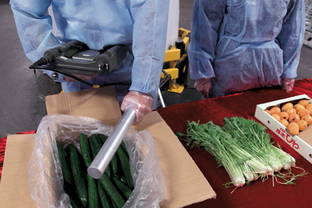
Staff of the CFS uses a hand-held survey meter to check the radiation levels of the food imported from Japan
On 11 March 2011 , a severe earthquake hit the east coast of the Miyagi prefecture of Japan which caused a devastating tsunami inflicting heavy casualties and massive destruction. The earthquake and tsunami damaged the cooling system of four reactors at the Fukushima Daiichi Nuclear Power Plant resulting in release of radioactive substances in the atmosphere and surrounding environment. The radioactive substances not only contaminated the surroundings but also the food produced in some areas of Japan .
Surveillance Operation
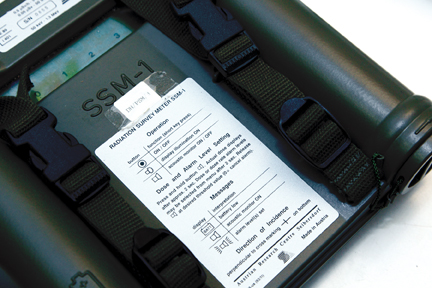
Hand-held survey meter used by the CFS
In view of the nuclear incident in Fukushima , the Centre for Food Safety (CFS) has stepped up surveillance at import level on food products from Japan , such as vegetables, fruits, milk, meat and aquatic products for radiological testing since 12 March 2011 . Samples of Japanese food were also taken at retail level for testing of radiation levels to ensure that food imported from Japan was safe for consumption.
Results and Related Measures
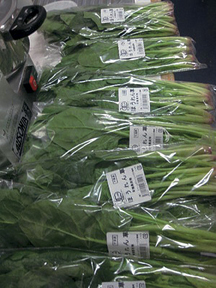
Vegetables and fruits imported from Japan account for less than 1% of market share in Hong Kong
Food products imported from Japan make up a low market share in Hong Kong, from less than 1% (e.g. vegetables and fruits) to about 5 % (e.g. meat, milk and frozen confections). As of August 2011, the CFS found that three samples of vegetables, including a spinach sample, a white radish sample and a turnip sample, imported from Chiba prefecture of Japan were detected to contain iodine-131 with a level exceeding the standards laid down by the Codex Alimentarius Commission (Codex) in the Guideline Levels for Radionuclides in Foods Contaminated following a Nuclear or Radiological Emergency (Guideline Levels). Based on risk assessment, the radiation dose for consumption of the consignment of contaminated foods for a year is equivalent to two-thirds to ten chest X-rays. Although consumption of the food would not pose immediate health risks, the CFS decided to impose import suspension for the sake of public health and food safety. The Director of Food and Environmental Hygiene (DFEH) made an order under section 78B of the Public Health and Municipal Services Ordinance (Cap.132) (the Order) to prohibit the import and also the supply or sale within Hong Kong with effect from noon on 24 March 2011 of food products which are/were harvested, manufactured, processed or packed from five prefectures of Japan, i.e. Fukushima, Ibaraki, Tochigi, Gunma and Chiba. Chilled or frozen game, meat and poultry, poultry eggs, and live, chilled or frozen aquatic products accompanied by a certificate issued by the competent authority of Japan certifying that the radiation levels do not exceed the standards laid down in the Guideline Levels can be exempted. The above foods which exceeded the standards laid down in the Guideline Levels were disposed of and did not enter the local market.
Conclusion
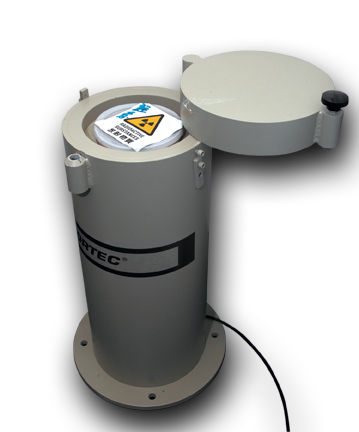
Equipment used by the CFS for testing radiation levels of food
Since the nuclear incident in Fukushima, the CFS has stepped up radiological testing of food products imported from Japan to ensure that the foods are free from radioactive contamination. As of 12 August 2011, a total of 38 693 food samples had been tested. The results were uploaded onto the following web site for reference by the public:
Furthermore, the CFS has kept close communication with the food traders, Japan authorities and the International Food Safety Authorities Network (INFOSAN) of the Food and Agriculture Organisation of the United Nations to secure the most updated information. The CFS will continue to strengthen food surveillance at both import and retail levels for food imported from Japan and closely monitor the situation.
Radiation and Food Safety
In fact, humans are constantly exposed to different kinds of radiations, including natural radiation. The unit of measurement for radiation dose is millisievert (mSv). The annual dose per capita received by the public in Hong Kong from natural radiation is about 2 mSv; whereas the annual dose per capita worldwide ranges from 1 mSv to 10 mSv. Ever since the Japan Fukushima nuclear incident, the radiation level in Hong Kong has remained normal.
The CFS has in place a routine food surveillance programme to ensure that all food products available on the local market are safe for consumption. In testing the radiation levels of food products, screening is first conducted by hand-held survey meter on the whole consignment, then with samples taken for examination by the Contamination Monitoring System (CMS) . Samples with a level exceeding the standards laid down in the Guideline Levels will be sent to Government Laboratory for further quantitative analysis of radionuclides (including iodine-131, caesium-134 and caesium-137).
The CFS currently adopts the standards laid down by Codex in the Guideline Levels in testing the radiation levels of food. According to Codex, when radionuclide levels in food do not exceed the standards laid down in the Guideline Levels, the food should be considered as safe for human consumption. If a consignment of food is tested to have exceeded the standards, the CFS will immediately mark and seal that consignment and arrange for disposal.
Advice to the trade
- Traders should source food ingredients from areas not affected by the incident.
Info Corner
Serving Size of Prepackaged Food for Nutrition Labelling
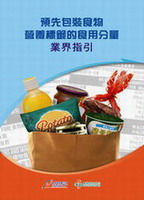
The CFS has published guidelines for reference by the trade
The Food and Drugs (Composition and Labelling)(Amendment: Requirements for Nutrition Labelling and Nutrition Claim) Regulation 2008 (the Amendment Regulation) came into effect in July 2010. Under the Amendment Regulation, all prepackaged foods are required to carry a nutrition label listing the contents of energy and the seven specified nutrients. Recently, the CFS in collaboration with the food trade has prepared the Trade Guidelines on Serving Size of Prepackaged Food for Nutrition Labelling which sets out the principles for determining serving size for different kinds of food. The Guidelines aims at encouraging and assisting the trade to provide information on the serving size of prepackaged food for the purpose of nutrition labelling according to good practice so as to facilitate consumers in understanding the nutrient content of the food product and making healthy food choices.
News on New Dishes
Safety Tips on Preparing " Spaghetti with Salmon and Spinach in White Sauce "
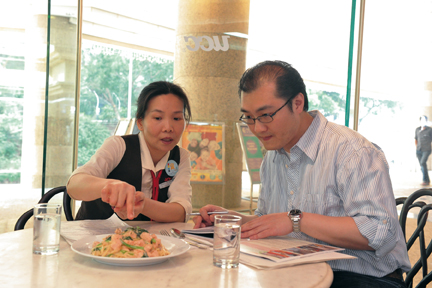
Ms NG, the Senior Chef of UCC, gives an interview to the CFS
To continue with News on New Dishes in the last issue, this time we interviewed UCC, another Signatory of the Food Safety Charter. One of UCC's very popular dishes is "Spaghetti with Salmon and Spinach in White Sauce". What are the tips for cooking this dish?
Ms Debbie NG, the Senior Chef of UCC, told us that it is a prepared-when-ordered dish and the tips for cooking it are as follows:
| How to Prepare | Tips | |
|---|---|---|
Receiving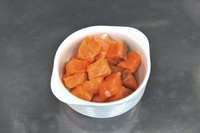 |
First of all, buy good quality chilled salmon and store it properly. | Chooseing good quality salmon is very important. Carefully inspect the salmon received to ensure freshness. |
Rinsing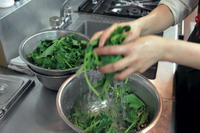 |
Wash the spinach thoroughly. Put the vegetable in icy water and set aside. | Keeping the spinach fresh and crunchy by placing it in icy water at low temperature. |
Cutting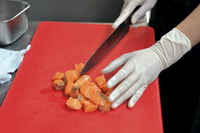 |
Dice the salmon into pieces of similar size. | Keeping the natural taste of salmon and ensuring thorough cooking, the diced salmon should not be too thin or too thick. |
Drizzling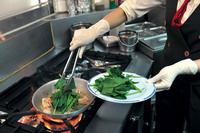 |
Heat olive oil and fry minced garlic until fragrant. Then add the salmon and season it to taste with proper amount of rice wine, black pepper, salt, secret recipe sauce and spinach in order. | Adding the ingredients quickly and stir-frying them at the same time to avoid over-cooking the salmon. Drizzling wine over the ingredients can bring out the aroma of salmon and make it tastier (Watch out for the flame while adding wine). |
Tossing 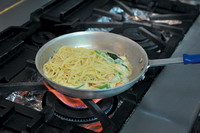 |
Finally, add the spaghetti well cooked in salted water and the white sauce from Japan. Fry and toss all ingredients thoroughly. Dish up and sprinkle it with chopped Chinese parsley. | Tossing all ingredients well to coat the spaghetti and salmon with the sauce. |
Pledges of UCC:
- To achieve perfect colour, aroma and taste of food, ingredients have to be fresh and the dish is prepared upon order. Fresh salmon delivered daily, white sauce flown in directly from Japan and skilful cooking are all essential.
- As quality ingredients are the foundation of making good dishes, UCC buys Norwegian salmon in one piece from reputable importers and adopts a "consumption-based" approach, i.e. to make purchase according to the estimated consumption of that day to ensure that the freshest salmon is served every day.
- The refrigerator in the food room will be cleaned, and its temperature checked and recorded in a record sheet regularly on a daily basis to ensure that it operates properly.
- In storing or preparing food, observe the principle of separating raw and cooked foods such as using labels in different colours to identify cutting boards, knives or other utensils for handling raw, cooked and ready-to-eat foods to avoid cross-contamination .
- Provide directives for cooking time and temperature for all dishes to ensure that food is thoroughly cooked .
- Various codes of hygiene (e.g. a code to govern the personal hygiene of staff) and operational guidelines (e.g. the temperature of the refrigerator as well as the cleanliness of the food room and eating utensils is regularly checked by designated staff) have been laid down. Some staff are even sent to Japan for training to acquire the knowledge of food hygiene and skills in handling ingredients.
Finally, in order to let its customers eat at ease, Ms NG said that UCC would continue to uphold the Food Safety Charter, practise the Five Keys to Food Safety and encourage its staff to attend food safety seminars organised by the CFS for the trade.
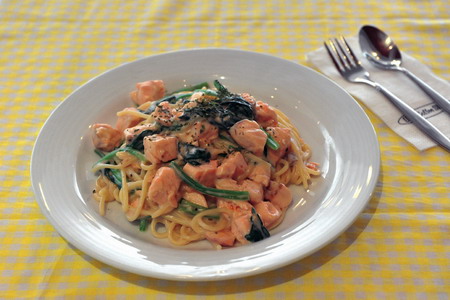
Freshly prepared " Spaghetti with Salmon and Spinach in White Sauce"
Briefing of Activities
"Food Safety Charter" Annual Meeting
Thanks to the active participation of the local food trade and the public recognition of the "Food Safety Charter" (the Charter), the Charter has just entered the third year smoothly.
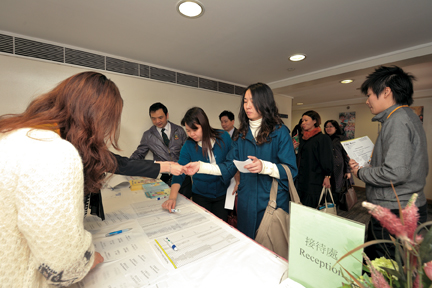 Registration of participants at entrance of the venue |
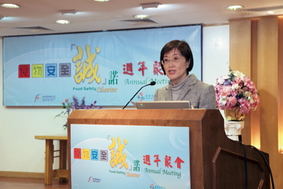 Dr Constance Chan, Controller of the Centre for Food Safety, delivers the opening speech |
|
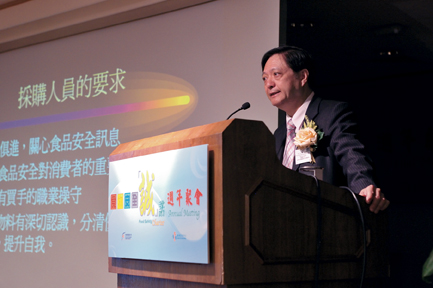 Mr LAU Kwong-choi, Director and Purchasing Manager of Banyan Group, explains the safety keys to purchasing food ingredients |
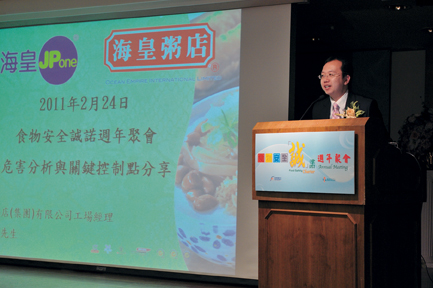 Mr Eric LIU, Factory Manager of Ocean Empire Food Shop, shares his experience in the implementation of the food safety management system |
|
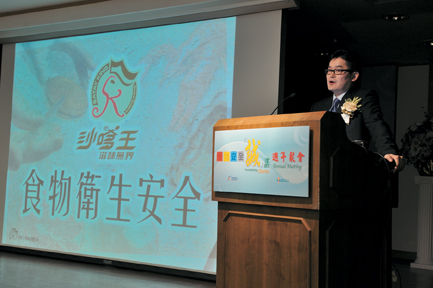 Mr CHEUNG Sek-ming, Chief Operating Officer of Satay King, shares his experience in obtaining ISO22000 certification |
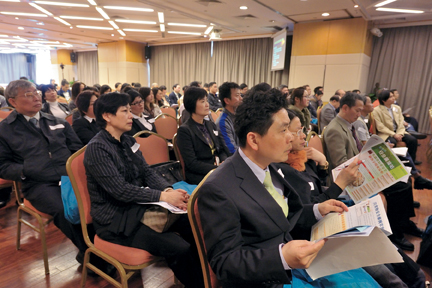 Participants listen attentively to the speaker |
|
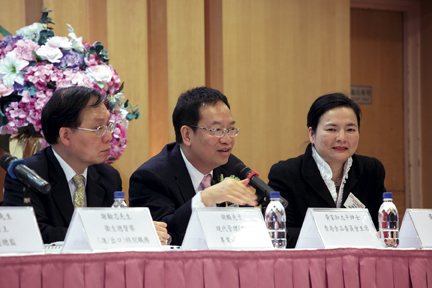 Mr WONG Ka-wo Simon, J.P., Chairman of the Hong Kong Food Council, and Mr WOO Lun, Vice Chairman of the Association of Restaurant Managers, host the focus discussion session |
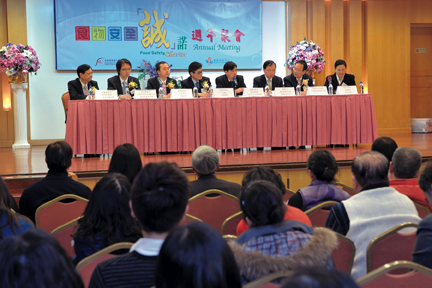 The speakers answer in detail questions raised by the participants |
Through the Charter, the CFS hopes to promote the "Five Keys to Food Safety" among the food premises to enhance food safety. This year, the Charter has in place a recognition scheme for food trade associations and licensed food premises that sign up to the Charter for three consecutive years. Signatories can be identified by means of the certificate and sticker of the Charter displayed on the premises.
Regional Symposium "From Food Incidents to Crisis Management"
Since its establishment on 2 May 2006 , the Centre for Food Safety (CFS) has adopted a food safety risk analysis framework promulgated by international food safety authorities. With the challenges from globalisation of food supply, the CFS has been working over the past five years to enhance surveillance of both local and imported food, respond proactively to food incidents, and implement a number of initiatives to improve its work in various areas of food safety control. In October 2010, the CFS was designated the World Health Organization Collaborating Centre (WHOCC) for Risk Analysis of Chemicals in Food.
To commemorate this landmark development and the fifth anniversary of the establishment, the CFS hosted a Regional Symposium featuring the theme "From Food Incidents to Crisis Management" at Hotel Nikko Hongkong, Tsim Sha Tsui East, Kowloon on 1 and 2 June 2011 . The objectives of the Symposium are to provide a platform for experience sharing, updating on food safety issues, fostering partnership and collaboration, and providing an opportunity for communicating with the trade.
The officiating guests included Dr York CHOW, Secretary for Food and Health, and Ms Jenny BISHOP, Technical Officer in Food Safety of the World Health Organization Western Pacific Regional Office. They joined Mr Clement LEUNG, J.P., Director of Food and Environmental Hygiene and Dr Constance CHAN, Controller of the CFS, in launching the light-up ceremony, formally kicking off the Regional Symposium. Ms Jenny BISHOP, on behalf of the World Health Organization, congratulated the CFS on the fifth anniversary of its establishment and on its designation as the World Health Organization Collaborating Centre for Risk Analysis of Chemicals in Food. She also talked at the Symposium about how the International Food Safety Authorities Network (INFOSAN) works.
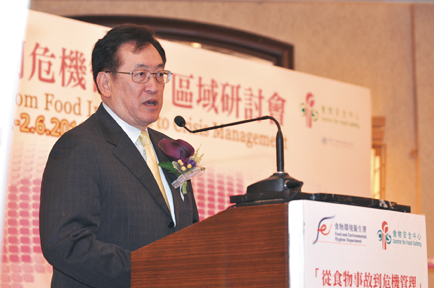
Secretary York CHOW delivers a speech at the opening ceremony
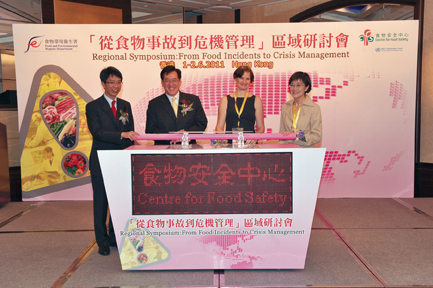
(From left) Mr Clement LEUNG, Director of Food and Environmental Hygiene; Dr York CHOW, Secretary for Food and Health; Ms Jenny BISHOP, representative of the World Health Organization and Dr Constance CHAN, Controller of the Centre for Food Safety launch the light-up ceremony to formally kick off the Regional Symposium
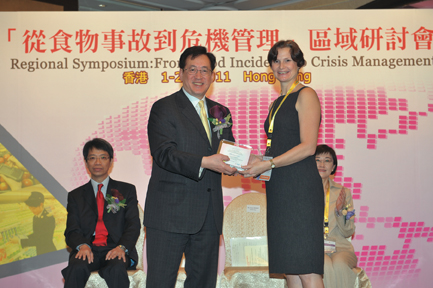
Dr York CHOW presents a souvenir to Ms Jenny BISHOP, representative of the World Health Organization
The Symposium drew food safety experts from overseas, the Mainland and the local community to deliver keynote speeches to share their experience and expertise. Guest speakers included Professor CHEN Junshi, Professor of National Institute of Nutrition and Food Safety, Chinese Centre for Disease Control and Prevention and Chair of Codex Committee on Food Additives; Professor LIU Xiumei, Professor of National Institute of Nutrition and Food Safety, Chinese Centre for Disease Control; Dr Dieter ARNOLD, International Consultant on Food Safety Systems and former Chairman of Joint FAO/WHO Expert Committee on Food Additives; Dr CHUA Sin-bin, Principal Consultant of Agrifood Technologies Pte Ltd of Singapore and Ms Noriko ISEKI, Senior Technical Officer, Food Safety Department of the Ministry of Health, Labour and Welfare of Japan.
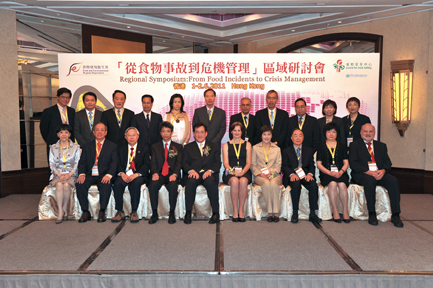
Group photo of guests
The Symposium, composed of plenary and parallel sessions, aimed to explore various topics of food incidents and crisis management from different aspects. The topics included Dealing with Food Emergencies, Chemical Food Incidents and Risk Communication, A Risk-based Approach to Food Incidents, Preparing for Future Challenges, etc. In view of an emergency happened in Japan before the Symposium, a Japanese speaker was invited timely to give a presentation on Food Safety Responses to Fukishima Nuclear Plant Incident in Japan. In this one and a half day Symposium, participants actively took part in different sessions to exchange views and share experience, fulfilling the objective of enhanced communication among the interested parties.
The Symposium was a success which attracted more than four hundred participants, including Government representatives, representatives from competent authorities on the Mainland and Macau , food trade members, physicians, academics and students. Participants showed favourable feedback and established close contact to make continuous concerted efforts in promoting food safety to safeguard public health.
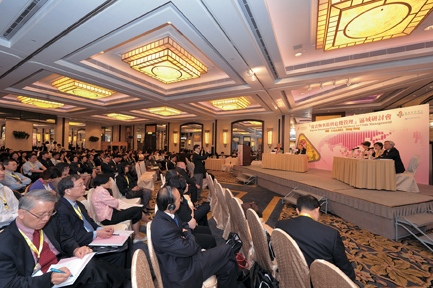
Active participation among different sectors
Upcoming Activities
(1) Briefing Sessions for the Food Safety Ordinance
The Food Safety Ordinance (the Ordinance) came into effect on 1 August 2011 . The Ordinance requires food importers and distributors to register with the Director of the Food and Environmental Hygiene Department. It also requires all food importers, distributors and retailers to keep records of transactions of the food business. There is a six-month grace period, ending on 31 January 2012 , for compliance with the two requirements.
To facilitate the food trade's understanding of the contents and the requirements of the new Ordinance, a series of briefing sessions have been arranged to take place from June 2011 to January 2012. Members of the trade are welcome to attend these briefing sessions . Those interested should download the reply slip from the web site of the Ordinance ( www.foodsafetyord.gov.hk). The c ompleted forms can be returned to the CFS by facsimile (fax number: 2893 3547 ) or mail (address: Risk Communication Section, 43/F, Queensway Government Offices, 66 Queensway, Hong Kong ). For enquiries, please call 2867 5147.
(2) Roving Exhibitions on Food Safety
The CFS regularly holds exhibitions at various public housing estates and major shopping centres. Exhibition panels on different topics such as food safety and nutrition labelling are displayed and educational videos are shown to enhance public knowledge of food safety. There are also games at the venues. Participants of the games will receive a souvenir. For details of the roving exhibitions, please visit the CFS web site (www.cfs.gov.hk) or contact the Communication Resource Unit on 2381 6096.
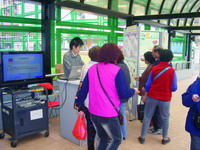
The CFS disseminates information on food safety to the public through roving exhibitions
Food Safety Q&A
|
Question:
|
A friend of mine says it is safe to eat mouldy food after removing or washing away the mouldy parts. Is it true?
|
|
|
Answer:
|
Food moulds are fungi that grow on food surface. There are many types of fungi, and most of them are visible only under microscope. Some fungi cause allergic reactions or respiratory problems. A few even produce poisonous substances that can make you sick. In fact, fungi have grown substantially on food by the time they are discernible to the naked eye. Even if you cut off or wash the mouldy parts, the mould hyphae that are invisible to the human eye, may have already penetrated the food. So, if food goes mouldy, discard it.
|
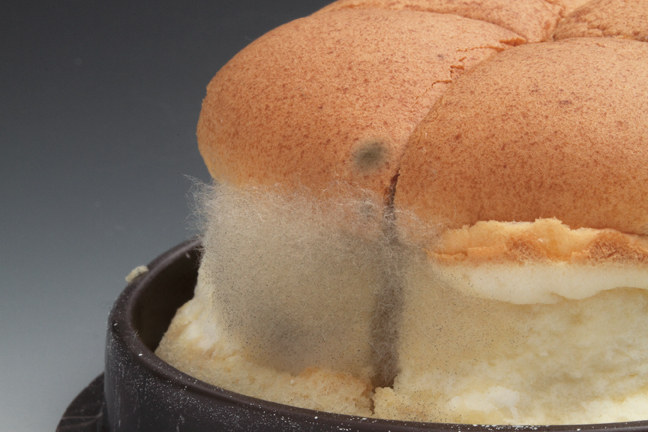 Food which goes mouldy has been contaminated by fungi and is not suitable for consumption |
Food with moulds discernible to the naked eye should be discarded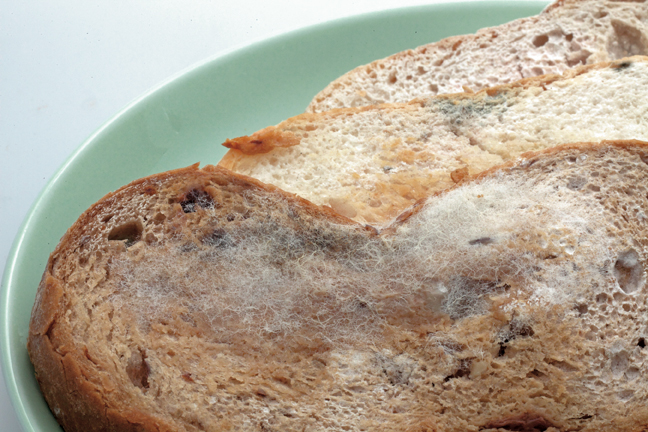 |
Facts and Myths
Are Opened Cans Reusable?
| Chef: |
You place so many empty cans on the table. Do you think that this is a recovery yard? You should discard them right away.
|
|
| Assistant: |
You see, these cans are very big. They are perfect for keeping food after being washed!
|
|
| Chef: |
Perfect? Do you know that opened cans may contain metal shards and will get rusty when they come into contact with water and oxygen? The food may then be contaminated and who consumes the food may be put at risk. You'd better use the newly bought stainless steel trays which have covers. They are easy to wash and will not affect food safety. Don't keep these empty cans. Go tidy up quickly. It's time to make preparations for the dinner session!
|
|
| Assistant: | OK! |
Brain Gym
How much do you know about food additives? Let's draw lines to match the following food additives with their corresponding uses!
|
Preservative
|
|
|
To add colour to food | |
|
Sweetener
|
|
|
To extend the shelf-life of food | |
|
Colour
|
|
|
To adjust the pH of food | |
|
Acidity regulator
|
|
|
To mix oil with water in food | |
|
Emulsifier
|
|
|
To impart sweetness to food |
